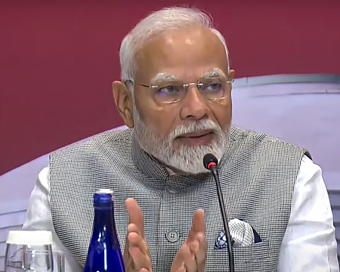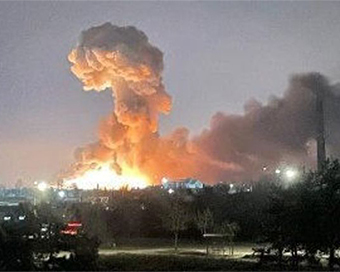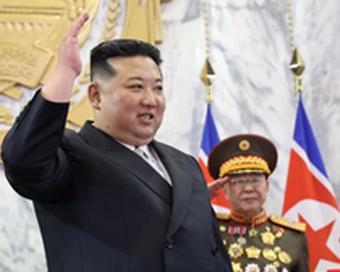 PM Modi visit USA
PM Modi visit USA Only the mirror in my washroom and phone gallery see the crazy me : Sara Khan
Only the mirror in my washroom and phone gallery see the crazy me : Sara Khan Karnataka rain fury: Photos of flooded streets, uprooted trees
Karnataka rain fury: Photos of flooded streets, uprooted trees Cannes 2022: Deepika Padukone stuns at the French Riviera in Sabyasachi outfit
Cannes 2022: Deepika Padukone stuns at the French Riviera in Sabyasachi outfit Ranbir Kapoor And Alia Bhatt's Wedding Pics - Sealed With A Kiss
Ranbir Kapoor And Alia Bhatt's Wedding Pics - Sealed With A Kiss Oscars 2022: Every Academy Award Winner
Oscars 2022: Every Academy Award Winner Shane Warne (1969-2022): Australian cricket legend's life in pictures
Shane Warne (1969-2022): Australian cricket legend's life in pictures Photos: What Russia's invasion of Ukraine looks like on the ground
Photos: What Russia's invasion of Ukraine looks like on the ground Lata Mangeshkar (1929-2022): A pictorial tribute to the 'Nightingale of India'
Lata Mangeshkar (1929-2022): A pictorial tribute to the 'Nightingale of India' PM Modi unveils 216-feet tall Statue of Equality in Hyderabad (PHOTOS)
PM Modi unveils 216-feet tall Statue of Equality in Hyderabad (PHOTOS)The Badminton Association of India (BAI) has announced a 14-member-strong India squad for
- Men’s Sr Hockey Nationals to be played in division-based format from April 4
- Mensik denies Djokovic 100th title in Miami final
- KIPG: Son of a vegetable vendor, Bihar’s Jhandu Kumar eyes Worlds, 2028 Paralympics
- Hardik Singh credits hard work and team unity for receiving HI Midfielder of the Year award
- Djokovic, Alcaraz land in same half of Miami draw
North Korea claims successful test of new intermediate-range hypersonic missile Last Updated : 07 Jan 2025 12:54:53 PM IST 
North Korea claims successful test of new intermediate-range hypersonic missile North Korea said on Tuesday that it has successfully test-fired a new intermediate-range ballistic missile (IRBM) tipped with a hypersonic warhead, claiming that the weapons system will reliably deter any rivals in the Pacific region.
But the South Korean military said the North's claimed success of a hypersonic missile launch could be "deception," raising questions about its flight distance and other specifications.
North Korea said the missile flew some 1,500 kilometres at 12 times the speed of sound the previous day during the testing overseen by leader Kim Jong-un via a monitoring system, Yonhap news agency reported quoting the Korean Central News Agency (KCNA).
The South's Joint Chiefs of Staff (JCS) said on Monday that the North's suspected hypersonic missile, fired from the Pyongyang area, flew about 1,100 km before falling into the East Sea.
The North Korean leader said the development of such a missile was aimed at bolstering the country's nuclear war deterrent by "making the weapon system to which no one can respond the linchpin of strategic deterrence."
"The hypersonic missile system will reliably contain any rivals in the Pacific region that can affect the security of our state," Kim was quoted as saying by the KCNA.
"The system can deal a serious military strike to a rival while effectively breaking any dense defensive barrier," he added.
The North's latest missile launch, the first provocation in about two months, came about two weeks before US President-elect Donald Trump assumes office on January 20.
It also came amid political turmoil in South Korea sparked by President Yoon Suk Yeol's botched martial law imposition last month and his subsequent impeachment by the National Assembly.
"North Korea probably intended to flex its muscle against the United States. As it said the latest launch was a test-firing, the weapons system does not appear to be completed, pointing to demand (to further develop) in terms of military technology," an official at South Korea's unification ministry told reporters.
A hypersonic missile is usually hard to intercept with existing missile defence shields. It travels at a speed of at least Mach 5 -- five times the speed of sound -- and is designed to be manoeuvrable on unpredictable flight paths and fly at low altitudes.
The KCNA said the hypersonic glide vehicle atop the new IRBM reached its first peak at a height of 99.8 km and the second at 42.5 km while making a 1,500-km-long flight as scheduled before hitting a designated target point at sea.
But the South Korean military dismissed the North's claim as a "deception," saying there was no second peak.
"The flight range analysed by South Korea, the US and Japan was around 1,100 km and (the missile) did not reach a second peak," JCS spokesperson Col. Lee Sung-un told a regular press briefing, noting the North has a track record of "exaggerating."
North Korea also claimed a new compound of carbon fibre was used in manufacturing the engine body of the hypersonic missile, and an unspecified "comprehensive and effective" method was introduced for the flight and guidance control system.
Experts said the North appeared to fire the upgraded version this week of a hypersonic missile that it launched in April last year. Pyongyang then claimed the IRBM loaded with a hypersonic glide vehicle flew 1,000 km.
The South's JCS then said the missile flew 600 km, calling the North's claims partially "exaggerated," although it said Pyongyang appears to have made some technological progress in its hypersonic weapons program.
"As the North has claimed it has acquired technology that is 'by no means easy,' there could be a technical improvement of its own. But it is also hard to exclude the possibility of technical cooperation from Russia," Hong Min, a senior research fellow at the Korea Institute for National Unification, said.
North Korea and Russia have been deepening military cooperation under a mutual defence treaty signed in June, with the North accused of sending more than 11,000 troops to Russia to support its war against Ukraine.
Hypersonic missiles, nuclear-powered submarines, spy satellites, and solid-fuel intercontinental ballistic missiles are among the sophisticated weapons Kim vowed to develop during a key party congress in 2021.
At a year-end party meeting, the North's leader said his country would carry out the "toughest" counteraction strategy toward the US and claimed that military cooperation among South Korea, the US and Japan has expanded into a "military bloc for aggression."IANS Seoul For Latest Updates Please-
Join us on
Follow us on








172.31.16.186







